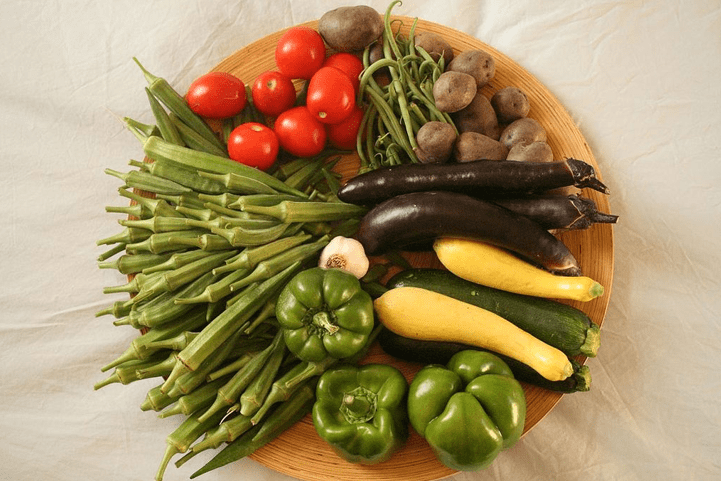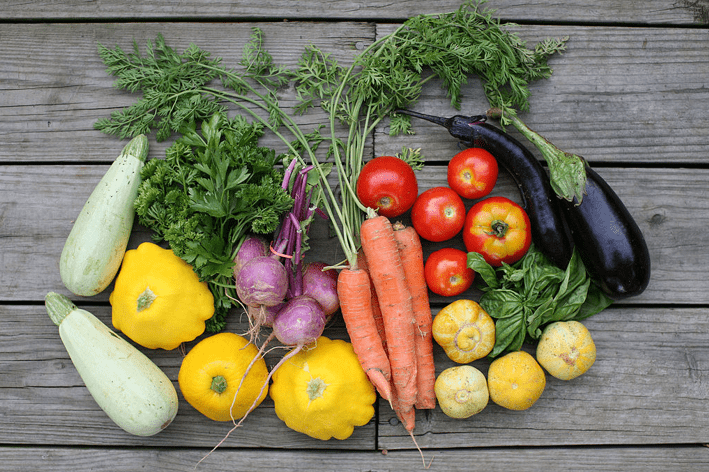Is a CSA Membership Through Local Farms a Great Food Choice For You?
Most people get their produce at supermarkets and never realize there is another option out there.
Farm sharing (AKA community supported agriculture or CSA) allows you to toss out the middleman and get your produce straight from local farms.
Interested in learning more about getting a CSA membership? Wondering how a farm share works? Not sure which CSA farm is right for you?
We will answer all of your questions with this year’s guide on community-supported agriculture. Here you will learn:
- A CSA definition
- How a CSA membership works
- What you get with a farm share
- The history of community-supported agriculture
- Benefits of farm sharing for you, the farm, and the environment
- Tips for choosing the right CSA farm for you
- Some disadvantages to a CSA membership keep in mind
In no time you and your family can be farm sharing and enjoying high-quality, tasty produce straight from a local harvest.
See Also: Top Agriculture Jobs | Ranking| Most Popular Jobs in Agriculture
What Is Community Supported Agriculture? A CSA Definition
CSA stands for community-supported agriculture. It can also be called “farm sharing.” Here is a general CSA definition:
- Members of the community (you!) can buy a “farm share” of a local farmer’s crops
- A CSA farm will use sustainable farming methods, and often times the produce is entirely organic
- Your farm share purchase is your CSA membership and it is typically all upfront for the entire season (normally you pay between December and April)
- You will have to choose how much of the farm sharing produce you want each week: this will depend upon how many people are in your family and how often you cook at home
- Each community-supported agriculture share will often cost between $200 and $600 each year depending upon how much you decide you will use (though some accept food stamps or will create a payment plan)
- That CSA farm will then give you a box or bag of produce each week or every other week during harvesting seasons; normally there is a convenient meetup spot where you do your pickup
- Typically the local harvest season can be expected to last from May through November
What Is Included In Your Weekly Farm Sharing Basket?
While most community-supported agriculture groups supply fruits and vegetables to their community. It is common to receive around 7 to 10 different types of produce in your weekly/bi-weekly basket that feeds 3 or 4 veggie eaters.



What is Community Supported Agriculture?
At some CSA farm locations, you get what you get. There is no choosing or swapping. Others allow you to choose what you want.
In addition, some local CSA farms will allow you to get half-shares. This can be a great option for individuals or couples. Or you can always double up your community-supported agriculture share to feed more family members.
And some of these farm sharing choices also offer additional options you can add to your CSA membership. These can include:
- Eggs
- Meat
- Cheese
- Artisanal bread
- Herbs
- Preserves
- Honey
- Flowers
You will often also get a newsletter that gives you cooking tips for the produce as well as information on any fun or interesting CSA farm activities coming soon.
Every CSA farm is different, so ask your local farmer what he or she offers.
Don’t Miss: American Agriculture | Guide | Everything You Need to Know (Facts & Types)
All-in-One Change Management Tools
Top Rated Toolkit for Change Managers.
Get Your Change Management Tool Today...
The History Of Farm Sharing
The concept of community-supported agriculture first started in some European countries and Japan in the mid-1900s.
According to the FairShare CSA coalition, they sprang up “as a response to concerns about food safety and the urbanization of agricultural land.”
Then in 1986 two local farms on the East Coast of the United States starting trying out the CSA membership model.
Now there are well over 12,000 CSA farms offering a wide variety of farm share options. Many of these are in the Midwest area of the USA. However, you can find farm sharing across the country.
Why A CSA Membership Benefits You
So know that you have a CSA definition and know how farm sharing works, let’s see why getting a local community-supported agriculture share can be so great for you and your family:
- You get the health benefits of fresh, local food
- You are avoiding genetically modified produce
- You get the taste/flavor benefits of seasonal produce
- You get to try to new produce you may not have or notice at your grocery store
- You get to know the farmer and the farm; often there is a big “open house” event so you can see exactly where and how your food is grown
- You get to know your community on pickup day
- You get your kids active, involved, and interested in food, their health, and their community
Not to mention you are supporting local farms –which brings us to our next section…



Why A CSA Membership Benefits Local Farms
Now that you know why community supported agriculture can be such an excellent choice for you and your family, let’s see why farm sharing can be so beneficial for small, local farms.
After all, these local CSA farms are the ones providing the local harvest we need to survive. It’s always a great idea to make sure they are cared for.
- Farmers get cash flow at the beginning of the season to cover their costs of repairs, seed, etc.
- Farmers can form relationships with their buyers; this helps them understand the buyer’s needs and wants
- Marketing their products starts before the growing process
- Farmers have options outside of joining large corporations with unique pressures; they do not have to sell out or change their values
Why A CSA Membership Benefits The Earth
Finally, we will wrap up with the benefits farm sharing has on the environment.
While the first two benefits of community-supported agriculture may be the top reasons people use a farm share instead of buying from a supermarket, the eco-friendly practices are another added bonus.
- Sustainable farming methods are used, which means the soil stays fertile
- Pesticides are not used which means not only the food you eat is safer, but so is the environment in general
- Your hard-earned dollars going to these farming practices instead of the large agribusiness farming methods sends a message that you value high-quality, safe food
- Many farms eliminate waste in greenways, like composting
- Since you go get your community-supported agriculture share in a basket, there is little to no packaging that will end in a landfill.









How To Choose Your CSA Farm and CSA Membership
If you are wanting to take advantage of all of these benefits and receive high-quality food from farm sharing, you will have to do some work to figure out which CSA farm is right for you.



Choosing a Local Harvest
Then you will need to decide what farm share option would make your idea CSA membership. Here are some steps to take:
Look online to see what local farms offer community supported agriculture; the website Local Harvest has a convenient search tool. Make a list of a few options then start your research. Meet the farmers and talk to them about their practices.
Important questions to ask the local farms are:
- Are they fully organic?
- What fertilizer do they use?
- What variety of crops do they harvest?
- How much are their CSA membership options?
- How many pieces of produce do they offer with their standard farm share?
- Where is the pickup location?
- How many weeks do they deliver?
- Do they offer community events like potlucks?
- What do they do if you are out of town on pickup day?
- Do they allow somebody else to pick up your basket for you?
- What other specialty items do they offer?
- Does the CSA farm outsource the specialty items or do they make them?
Related: Top Agriculture Colleges, Schools and Universities | Ranking | Agriculture Universities Ranking
Downsides Of A CSA Membership
Up until now, we have focused on how great community supported agriculture is – that is because farm sharing is a wonderful option for so many families.
But we must also mention some potential downsides that may pop up with your CSA membership.
- You have to cook with fresh produce each week to make the investment worth it.
- You will have to be willing to make your meals based on what popped up in your community-supported agriculture share basket that week.
- Most of the time, the farm sharing payment is all upfront. This means you have to have a few hundred dollars at one time.
- It is possible that you repeatedly get certain crops you do not like.
- You cannot vacation many times when your local farms are giving their produce, otherwise, you miss out on your investment.
- You may have extra produce at the end of the week
- Sometimes a local harvest does not yield what it is supposed to yield. There is a chance some risk could be involved due to bad weather or insect infestation.
Under these conditions, a CSA membership may not be ideal for you. However, many people can find a way to make it work.
Sometimes you can share the cost of a farm share with another family. This way somebody still gets the produce if you are out of town. Also, if you don’t like beets, give the beets to the other family. Then they will give you the kale they don’t care for.
Also, creating your own mini compost can give you an option for the leftover produce at the end of the week.
Free Wealth & Finance Software - Get Yours Now ►
Conclusion – Is Farm Sharing Right For You?
Now that you have a CSA definition and understand how farm sharing works, you can decide if a CSA membership is a great idea for you and your family this year.
Remember to take the time to talk to each CSA farm so you can know exactly what to expect from the local harvest. Then see if any friends want to join you in a farm share for the season.
You and your family will have a fun experience partnering up with local farms. And with community-supported agriculture, you will be promoting a healthy lifestyle while doing something good for your community and the environment.
Popular Article: Top Agricultural Products | Guide | List of Agricultural Products & Crops
Image Sources:
- https://upload.wikimedia.org/wikipedia/commons/thumb/2/23/Clagett_Farm_CSA_Week_11.jpg/1024px-Clagett_Farm_CSA_Week_11.jpg
- https://upload.wikimedia.org/wikipedia/commons/thumb/2/2e/CSA_Week9.jpg/1024px-CSA_Week9.jpg
AdvisoryHQ (AHQ) Disclaimer:
Reasonable efforts have been made by AdvisoryHQ to present accurate information, however all info is presented without warranty. Review AdvisoryHQ’s Terms for details. Also review each firm’s site for the most updated data, rates and info.
Note: Firms and products, including the one(s) reviewed above, may be AdvisoryHQ's affiliates. Click to view AdvisoryHQ's advertiser disclosures.



